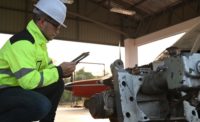Evolving Quality Processes Propel Growth
All inspectors are initially trained in first article inspection and then on assembly, sheet metal, and CMM inspection.

Mike Terrell is the quality assurance manager at B&B Airparts Inc., a machine shop that specializes in manufacturing high precision parts for aerospace OEMs. B&B Airparts Inc. has been in business for over twenty years, offering machining, sheet metal fabrication, and assembly capabilities.
Mike Terrell is the quality assurance manager at B&B Airparts Inc., a machine shop that specializes in manufacturing high precision parts for aerospace OEMs. B&B Airparts Inc. has been in business for over twenty years, offering machining, sheet metal fabrication, and assembly capabilities.
When Terrell joined B&B Airparts Inc. in 2016 the company was in a period of tremendous growth. Terrell and his team were tasked with completing upwards of 350 FAIs per month, and many were new parts. He used a combination of new technology and process changes to transform the quality department which has enabled B&B Airparts Inc. to continue their rapid growth.
At the time their first articles were done after the part was manufactured. A finished part would come to quality, where then Terrell and his team would manually bubble the part drawing, measure the part, and complete the AS9102 first article inspection report. On some parts, it was only two to three hours to complete a FAIR, but on other parts, it could take one to two days. This was particularly cumbersome and time-consuming when it came to new parts, where there were more unknowns for both manufacturing and quality teams to work through. This resulted in a backlog in quality, and he knew that in order for the company to continue on its impressive growth trajectory, that quality would need to become more efficient in creating AS9102 FAIRs.
50% Time Savings Creating AS90102 First Article Inspection Reports
Since implementing InspectionXpert, B&B Airparts Inc. has cut its FAIR time in half. Terrell’s team is able to balloon the part drawing and simultaneously capture the tolerances. The software automatically applies upper and lower spec limits. This means once ballooning is done they can quickly export to an Excel FAI sheet that inspectors can fill out with dimensional data.
Faster FAIRs Enables Shorter Lead Times
Terrell saw another opportunity for improvement and began doing first articles as a part of their planning review for new part production. Now they balloon the part drawing and use that as a control plan to create the FAI before manufacturing a new part. As a result, the quality team is able to review the FAI and find any issues before production, such as discovering they’ll need to update tooling or measurement resources in order to produce and verify a new part.
Terrell and his team have been able to standardize their FAI process as a whole, and streamlined communication across teams. All of these changes in inspection planning and reporting have decreased lead time for the quality team. According to Terrell, “Finding and addressing potential issues before production has had a huge impact on turnaround time.”
Reduction of Non-Conformances
Moving the ballooning and report creation to the beginning of the process has also helped B&B Airparts Inc. reduce nonconformance:
• Clearer Requirements. Since all requirements are stated before production, inspectors have another opportunity to review all requirements and clarify before the part goes to production.
• Key Characteristics Identified Earlier. The ballooned part drawing doubles as a control plan to call out key characteristics for the shop. Machinists are able to check key characteristics on the floor at the point of production.
Training for Standardization & Consistency
B&B Airparts Inc. has over 43 customers, and although all their first article inspection reporting is based on the AS9102 standard, each customer has a specific way that forms need to be filled out. B&B Airparts Inc. has implemented thorough training documentation for each customer, along with annual training to ensure that all inspectors are familiar with each customer’s unique requirements. They have also customized the report outputs from InspectionXpert so that it’s easy for the quality team to create the right inspection forms for each customer.
Cross-training has been another pivotal component of making the quality team more agile. All inspectors are initially trained in first article inspection and then on assembly, sheet metal, and CMM inspection. Every six to 12 months inspectors are rotated from one section to another. When a part goes through, each inspector knows how to fill out their section, and can also review other sections, so that they can have each other’s backs. This also means that if there is an urgent need in one area the inspectors can respond quickly moving from one area to another to ensure that quality processes run uninterrupted.
Efficiency Drives Growth
Since Terrell joined B&B Airparts Inc. in 2016 the company has tripled in size. Changes in software and process have enabled the quality team at B&B Airparts Inc. to maintain 100% inspection and continue to deliver high-quality products on-time to their customers. As Terrell said, “We simply would not have been able to keep up with the growth of our company without InspectionXpert and these changes in our process.”
Looking for a reprint of this article?
From high-res PDFs to custom plaques, order your copy today!





